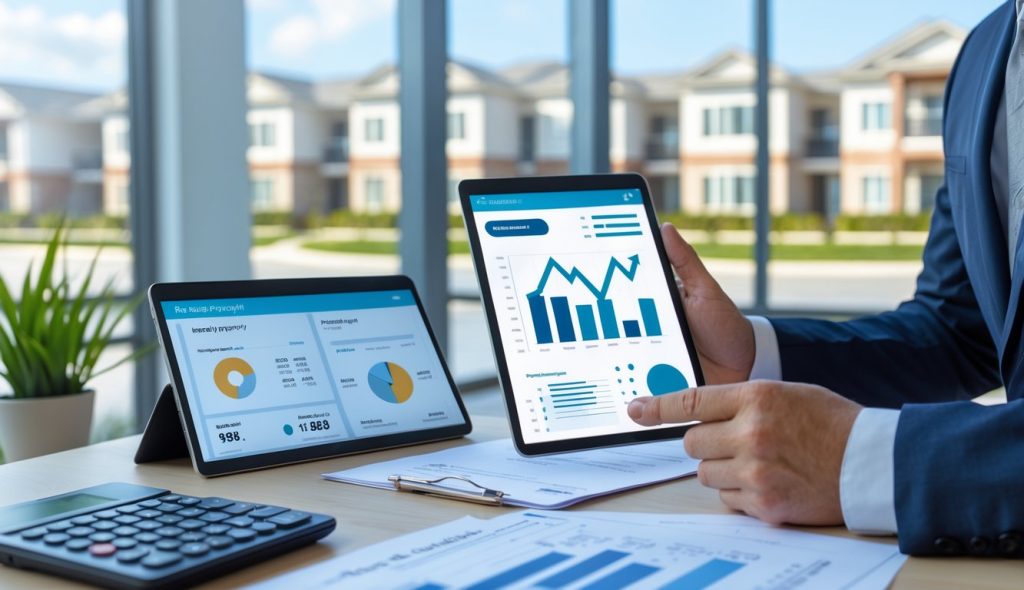How To Reduce Rental Property Operating Costs

Maintaining a healthy cash flow while keeping tenants satisfied is crucial for your success as a rental property owner or manager. Economic changes, such as Trump’s tariffs, can impact your bottom line, making it more important than ever to control expenses and maintain high occupancy levels.
This article shares practical methods you can use to lower rental property operating costs and address issues like rent collection risk during challenging times, without sacrificing quality for your tenants.
Key Takeaways
- Find ways to streamline and minimize operating costs.
- Keep tenants happy while improving your financial results.
- Apply strategies to address economic challenges.
Analyzing Operating Costs
To keep your rental property profitable, break down your operating costs and see how they affect your net operating income (NOI). Start by listing major operating expenses, such as utilities, property taxes, landlord insurance, repairs, maintenance, and legal fees. These costs directly affect your rental income and cash flow, so reviewing them regularly helps you save money and keep a healthy ROI.
| Expense Type | Examples | Frequency | Impact on NOI |
|---|---|---|---|
| Utilities | Water, gas, electricity | Monthly | High |
| Property Taxes | Annual assessments | Yearly | Significant |
| Insurance Premiums | Landlord insurance | Yearly | Moderate |
| Repairs & Maintenance | Appliance replacement, HVAC | As needed | Variable |
| Legal Fees | Lease agreements, disputes | Occasional | Varies |
Try using a ratio utility billing system (RUBS) to share utility costs fairly or invest in energy-efficient upgrades like LED lighting and solar panels to lower energy bills. Review your insurance policies to make sure you’re not overpaying and take advantage of any discounts. Shop around for insurance and adjust your coverage to fit your property’s value and the current market.
Watch your operating expense ratios and adjust spending as needed. Use tax deductions and check for inefficiencies to help you save money and increase your property’s profitability and net operating income.
Reducing Repairs and Maintenance Costs
You can lower repairs and maintenance costs by focusing on preventative maintenance. Schedule regular inspections and fix small issues early to avoid costly repairs later. For example, check for leaks, mold, or faulty wiring every few months to cut down on emergency repair calls.
Some essential routine maintenance tasks include:
- Changing HVAC air filters
- Testing and replacing smoke alarm batteries
- Clearing gutters and downspouts
- Inspecting roofs and siding for damage
Work with reliable local service providers for better pricing and faster service than you’d get from large national companies. If you manage more than one property, negotiate bulk contracts with preferred vendors to unlock savings.
Taking care of your property’s exterior helps preserve value and prevents costly deferred repairs. Staying proactive with maintenance lowers your overall costs, keeps tenants happy, and extends the life of your property’s systems. You can find affordable contractor options that fit different budgets at utilizing the skills of local contractors.
Identifying Inefficiencies in Property Management

To spot inefficiencies in property management, review your processes for tenant communication, maintenance scheduling, rent collection, and tenant screening. Use digital platforms to automate tasks like rent collection and screening, which makes your workflow more efficient and reduces manual mistakes.
For example, you can automate routine tasks to save time and limit unnecessary manual work. You can read more about automating property management tasks in this property management operational efficiency guide.
Key areas to examine include:
- Tenant communication: Do you handle frequent emails or calls about rent payments? Repeated issues may mean you need better systems.
- Maintenance management: Are repairs delayed because of poor scheduling or missing documentation?
- Task automation: Are you still doing manual tenant screening or using old payment methods?
Track indicators like vacancy rates, turnover costs, and occupancy levels to spot weak points in your operations. Use the table below to help assess potential inefficiencies:
| Area | Key Indicator | Potential Solution |
|---|---|---|
| Rent Collection | Frequent payment issues | Automate with digital tools |
| Tenant Screening | Slow processing times | Use screening platforms |
| Vacancy Rate | High/unexplained vacancies | Revisit screening and marketing |
| Communication | Repeated tenant complaints | Centralize communications |
Investing in Energy Efficient Solutions
When you upgrade your rental units with energy-efficient solutions, you can lower utility costs and attract tenants who want affordable, eco-friendly living. Common upgrades include LED lighting, high-efficiency HVAC systems, and modern energy-efficient appliances. These improvements can also raise your property’s value and keep tenants satisfied.
Consider the following options:
| Solution | Benefits |
|---|---|
| LED lighting | Longer lifespan, lower electricity usage |
| Energy-efficient appliances | Reduced energy bills, improved performance |
| Programmable thermostats | Controlled heating/cooling, increased efficiency |
| Smart thermostats | Remote access, optimized energy usage |
Other upgrades like weather stripping and water-saving fixtures can help you cut waste and lower monthly bills. Hire a certified professional to assess your property and suggest improvements while making sure you follow local rules. For more ideas, check out strategies for reducing the operating costs of a rental.
Utilizing Technology To Automate Tasks and Reduce Labor Costs
Property management software lets you automate routine tasks like rent collection, tenant screening, and regular communications. This reduces the need for manual staff, leading to noticeable decreases in both administrative costs and labor costs over time. Automated systems streamline maintenance by quickly handling requests and scheduling repairs, which boosts efficiency and keeps tenants happy.
Smart platforms can centralize your data, send reminders for lease renewals, and manage service requests, saving both time and money. When you use secure and regularly updated technology, you help ensure compliance and reliability.
| Task | Automation Benefit | Cost Impact |
|---|---|---|
| Rent Collection | Recurring online payments | Lower admin and labor |
| Tenant Screening | Instant background checks | Reduced manual work |
| Maintenance Requests | Automated scheduling & tracking | Streamline maintenance |
For more details on practical applications of automation in property management, visit this guide on how to reduce rental property operating costs.
Eliminating Unnecessary Spending on Amenities and Upgrades

Careful budgeting helps you decide which amenities and upgrades to add to your rental property. Not every feature will boost tenant satisfaction or occupancy rates. Start by reviewing recent upgrade expenses and see if each investment provided measurable value.
List your current and proposed amenities, and compare projected costs with expected benefits:
| Amenity/Upgrade | Estimated Cost | Potential Impact on Tenant Retention | Likelihood to Increase Rent/Value |
|---|---|---|---|
| In-unit Washer/Dryer | High | Moderate to High | Moderate |
| High-speed Internet | Medium | High | High |
| Luxury Pool | Very High | Low to Moderate | Low |
Instead of choosing expensive upgrades by default, focus on those that matter most to your tenants. Use surveys to gather feedback and direct your spending where it counts.
Evaluating the return on investment for each enhancement can help you avoid overspending on features that don’t support your marketing goals. Practical amenities usually deliver more value than costly luxuries that tenants rarely use. When you align upgrades with marketing and advertising efforts, you maximize tenant appeal and cost efficiency.
Lease agreement updates can reflect value-added amenities that justify mild rent increases. Lease renewal incentives—such as minor upgrades or discounts—can encourage tenants to stay without major expenses. Find more ideas in landlord cost control strategies on how to reduce operational costs.
Frequently Asked Questions

What are effective strategies for lowering maintenance expenses on rental properties?
Performing regular preventive maintenance helps you spot issues early and avoid expensive repairs. Standardizing appliances and working with reliable contractors can also reduce costs and make repairs more efficient.
How can landlords negotiate better rates with property management companies?
Landlords can compare offers from several companies and ask for a detailed breakdown of fees. Highlighting a long-term partnership or a portfolio of properties can help you negotiate a better rate.
What tax deductions can rental property owners take advantage of to reduce operating costs?
Rental property owners can deduct expenses like mortgage interest, property taxes, repairs, maintenance, depreciation, insurance, and travel related to property management. It’s a good idea to review IRS guidelines or consult a tax professional for the best results.
In which ways can energy efficiency improvements lead to cost savings for rental property owners?
Energy-efficient upgrades like LED lighting, low-flow fixtures, and better insulation lower utility bills and reduce heating and cooling costs. Some improvements may also qualify for rebates or incentives from local programs.
What are the best practices for setting rent prices to cover operating expenses while remaining competitive?
Research similar properties in your area to set a fair price, and make sure to include all your expenses when calculating rent. Highlighting valuable amenities and reviewing your rates regularly helps you stay competitive and cover your costs.
How can implementing technology in property management reduce overall operating costs?
Online payment platforms help reduce late payments and minimize manual processing. Property management software simplifies accounting, maintenance requests, and communication between landlords and tenants. Virtual tours and automated listings make leasing faster and help fill vacancies sooner. Smart home devices like remote locks and thermostats cut down on on-site visits and boost efficiency.
Ready to maximize your rental property’s true potential?
Never miss a rent increase opportunity again! Get real-time alerts and market updates from RentCast.io and save 20% with promo code BIGDEAL.

Master the art of real estate investing with The Real Estate Property Management Guide: Premium Edition – your comprehensive roadmap to successful property management.
Whether you’re a novice investor or seasoned professional, this guide covers everything from selecting the right investment properties to tenant management and property marketing.
The author, Jeff Rohde writing as Jeffrey Roark, is a professional with over 25 years of real estate experience. This Premium Edition includes the valuable bonus book Investment Real Estate Analysis: A Case Study to help you identify hidden opportunities and evaluate properties like a professional.
Learn practical, actionable strategies for both residential and commercial properties, from single-family homes to office buildings and shopping centers.
Don’t just buy property – learn how to manage it successfully and maximize your investment potential.
Grab your copy now from your favorite bookseller:
- Amazon (Basic Edition, does not include Investment Real Estate Analysis: A Case Study)
- Books2Read for Apple, Barnes & Noble, Kobo, Scribed, and 8 more sellers with both eBook and paperback options available (Premium Edition, includes Investment Real Estate Analysis: A Case Study)
- Payhip as a downloadable PDF (Premium Edition)
Ready to take your business to the next level?
- Subscribe to our newsletter
- Visit the learning center
- Learn more about our consulting services